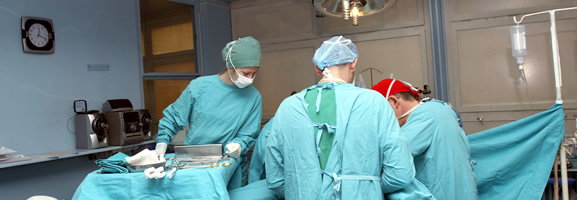What is a fusion operation?
Fusion simply means joining two bones together in a solid manner, thus preventing future movement between the bones.
Lumbar spine fusions can be performed from the front of the spine, (anterior approach) or from the back of the spine, (posterior approach). On occasions they may need a combined approach from the front and the back.
Bone or bone substitutes are used to fuse the bones together. Within the spine the bone graft may be placed posteriorly,between adjacent transverse processes (Posterolateral Fusion), or anteriorly, between the vertebral bodies (Interbody fusion). Certain techniques allow both fusions to be performed, resulting in a circumferencial fusion or 360 degree fusion. The bone may be stabilized with instrumentation, while the bone graft knits together.
Do I need a fusion operation?
Fusions are performed within the lumbar spine for a variety of reasons.
Back pain, may be caused by a degenerate lumbar disc. Under these circumstances a lumbar fusion aims to prevent movement between the adjacent vertebrae and so reduce this pain.
Instability of the spine may result in a spondylolisthesis, movement of one vertebra relative to the adjacent vertebra, which may lead to back pain or pressure on the nerves, which may cause leg pain. The spondylolisthesis may be reduced and fused, or under certain circumstances, fused in its slipped position.
Lumbar decompression surgery is used to relieve pressure on the nerves within the spine. If the spine is unstable or the process of the decompression results in the spine becoming unstable, then the decompression may be combined with a spinal fusion.
What other treatment options are there?
Injections into the spine
These procedures are used when pain relief is required, yet surgery is not immediately indicated. Leg pain may be relieved by an epidural or a nerve root block and back pain may be improved with facet joint injections. (See spinal injections)
Non fusion surgery
The spine may be stabilized without fusing the spine. Techniques include Dyneses where by pedicle screws are placed into adjacent vertebrae and then connected together by a non-rigid structure. This has the advantage of maintaining movement within the spine, but may not be suitable for every condition. Suitability for the Dyneses procedure depends on the type of problem within the spine and the severity of thecondition.
Disc Replacement Surgery
Cervical disc replacement is becoming a widely used technique for the relief of arm pain secondary to cervical nerve root compression, however disc replacements within the lumbar spine has had a much more varied outcome and is not a universally accepted technique for the relief of chronic lumbar back pain.
Types of lumbar Fusion
Posterior lumbar fusion
Bone is placed between the transverse processes (T.P.) of adjacent vertebrae. (There are two T.P.s, one on each side of the vertebra, which project outwards). The bone placed between the two adjacent vertebrae heals to produce a solid fusion between adjacent vertebral bodies within the spine.
Frequently the spine is stabilised with spinal instrumentation while the bone heals. This can be performed in a variety of ways depending upon the precise indications for the surgery.
PLIF or Posterior Lumbar Interbody Fusion
This technique allows circumferencial fusion of the spine as well as allowing decompression of the nerve roots (relieving the pressure on the nerves within the spine).
Pedicle screws are inserted in the same manner as for an instrumented posterior-lateral fusion. The lamina at the back of the spine is then removed and the intervertebral disc between the vertebral bodies is removed. The nerve roots are then temporarily retracted out of the way to allow cages packed with bone graft to be inserted between the vertebral bodies.
The pedicle screws are connected together with the rods and more bone graft is placed between the transverse processes of the vertebral bodies, to obtain a fusion
TLIF or Transforaminal Lumbar Interbody Fusion
This technique allows circumferencial fusion of the spine but avoid removal of the lamina of the spine. It also causes less disruption to the posterior muscles of the spine, as the surgery can be performed between the muscles, rather than displacing them off the spinous processes.
Pedicle screws are inserted in the same manner as for an instrumented posterior-lateral fusion. The facets join at the back of the spine is then removed and the intervertebral disc between the vertebral bodies is removed. A single nerve root is then temporarily retracted out of the way to allow a curved cage packed with bone graft to be inserted between the vertebral bodies.
The pedicle screws are connected together with the rods and more bone graft is placed between the transverse processes of the vertebral bodies, to obtain a fusion





